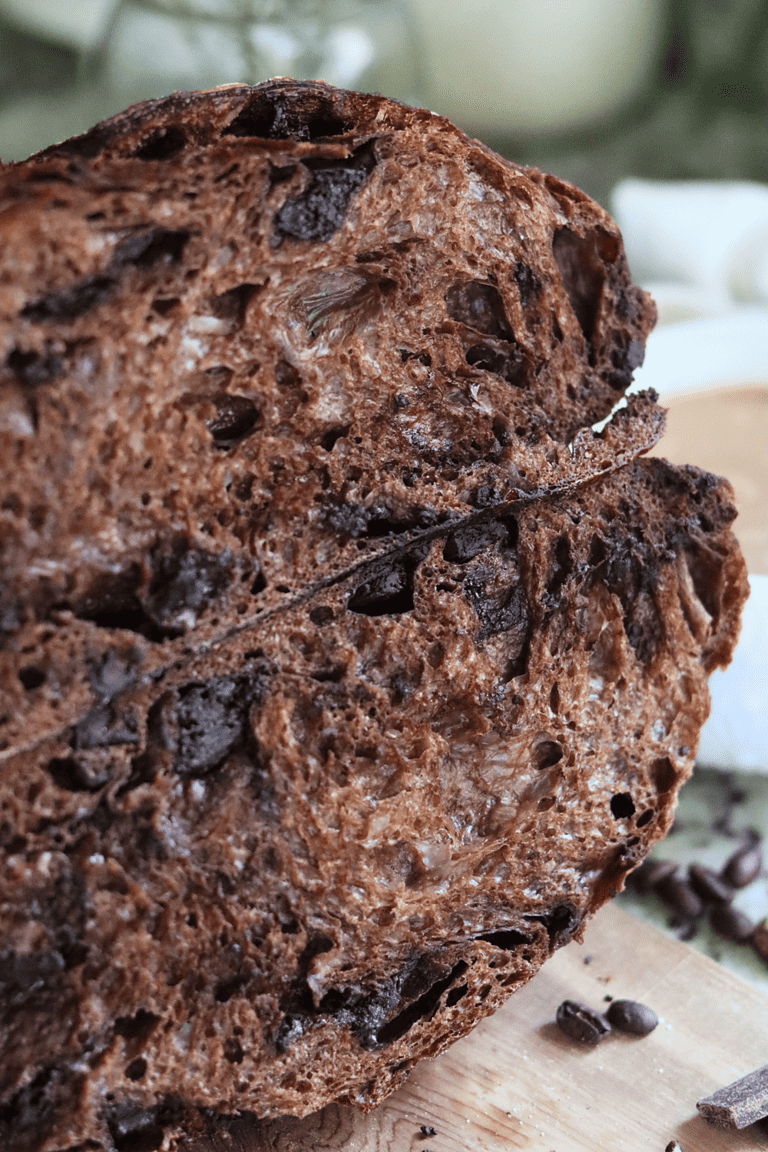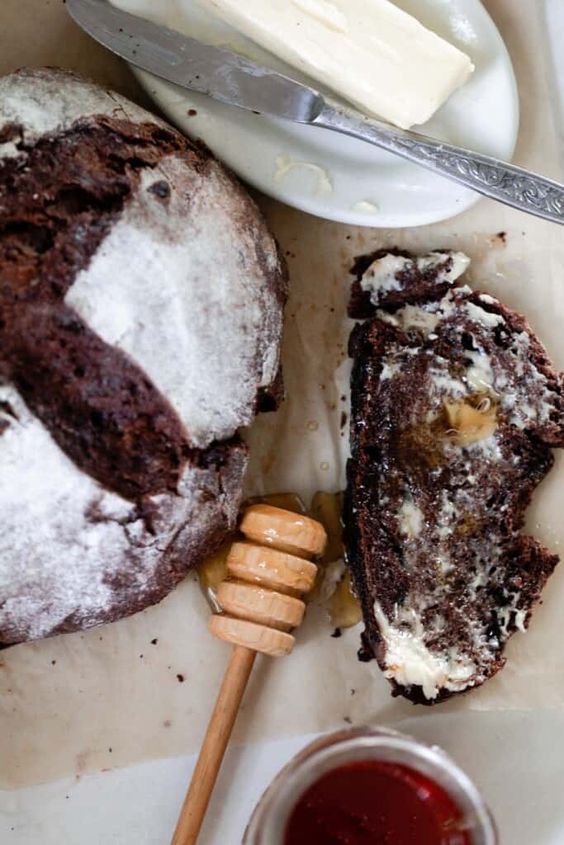Double Chocolate Espresso Sourdough Bread offers a delightful blend of tangy sourdough and rich chocolate flavors. This indulgent loaf is packed with cocoa powder, filled with dark chocolate chunks, and subtly sweetened with brown sugar and a hint of cinnamon. Enjoy it warm, slathered with high-quality butter, for a truly satisfying sourdough experience.

WHY YOU’LL LOVE THIS RECIPE
RICH CHOCOLATE FLAVOR
Indulge in the decadent taste of Double Chocolate Espresso Sourdough Bread, brimming with rich chocolate goodness. With natural cocoa powder and generous chunks of melted chocolate, this bread will keep chocolate lovers coming back for more.
NO-KNEAD, EASY RECIPE
Say goodbye to the hassle of kneading! This simple recipe requires just a few sets of stretch and folds, allowing you to create the perfect structure for your Chocolate Sourdough Bread without the need for a stand mixer or intensive hand-kneading.
DELICIOUS FERMENTED SWEET TREAT
Enjoy the benefits of long fermentation with this Chocolate Espresso Sourdough Bread. The sourdough starter aids in breaking down the phytic acid naturally present in flour, making it easier for your body to digest while providing a delightful flavor.
INGREDIENTS
- 4 Tablespoons boiling water
- 1 Tablespoon instant espresso (or 50g brewed coffee as a substitute)
- 50g active, bubbly starter (approximately 2 tablespoons)
- 325 ml warm water (about 1 1/2 cups)
- 50g brown sugar (about 1/4 cup)
- 470g bread flour (approximately 2 1/2 cups)
- 11g salt (about 2 teaspoons)
- 30g unsweetened cocoa powder (approximately 1/3 cup)
- 1 teaspoon ground cinnamon (3g)
- 180g chocolate chunks (about 1 cup)
INSTRUCTIONS

Step 1: Prepare the Espresso
- In a small bowl or coffee cup, mix 4 tablespoons of boiling water with 1 tablespoon of instant espresso. If you don’t have espresso powder, you can use instant coffee as a substitute. Mix well and set aside. Alternatively, you can use 50g (about 4 tablespoons) of brewed coffee.
Step 2: Make the Dough
- In a large mixing bowl, combine 50g of your mature starter, 325 ml of warm water, the prepared espresso, and 50g of brown sugar. Mix until it resembles a milky liquid.
- In a separate medium bowl, whisk together 470g of bread flour, 30g of cocoa powder, 3g of ground cinnamon, and 11g of salt. This helps ensure a consistent color in your bread.
- Gradually add the dry ingredients to the wet mixture, mixing until all the flour is incorporated. The dough will be shaggy at this stage.
- Cover the bowl with a damp tea towel or a reusable shower cap and let it rest for at least 30 minutes.
Step 3: Stretch and Fold
- After resting, use slightly wet fingers to scrape the dough from the sides of the bowl. Stretch a section of the dough above the bowl and fold it over itself.
- Rotate the bowl a quarter turn and repeat the stretching and folding until you’ve gone all the way around. The dough will begin to look smoother.
- Cover and let the dough rest for another 30 minutes.
Step 4: Incorporate the Chocolate
- Gather 180g of chocolate chunks and sprinkle them over the top of the dough.
- Perform another set of stretch and folds, incorporating the chocolate into the dough. Don’t worry if some chunks break through.
- Cover and rest for 30 minutes.
- Repeat the stretch and fold process three more times, allowing 30 minutes of rest between each round.
Step 5: Bulk Fermentation
- After completing all stretch and folds, cover the dough again and leave it to bulk ferment on the countertop. The duration of this step will depend on your room temperature:
- 68-70°F: 6-9 hours.
- Look for signs that the dough is ready:
- It has increased in size by 50%.
- It appears light and jiggles when shaken.
- It pulls away easily from the bowl.
- Visible bubbles should be present.
- It passes the windowpane test.
Step 6: Pre-Shape the Dough
- With wet fingers, gently release the dough from the bowl without deflating it too much.
- Tilt the bowl to allow the dough to fall onto a floured surface.
- Perform a stretch and fold again to shape the dough, then let it rest for 30 minutes.
Step 7: Prepare the Proofing Basket
- While the dough rests, prepare your proofing basket (banneton or a bowl lined with a tea towel) by dusting it with flour to prevent sticking.
Step 8: Final Shaping
- After resting, flip the dough so the floured side is down.
- Fold the bottom of the dough towards the center, then do the same with the sides and the top.
- Flip the dough seam side down and gently cup your hands around it, turning it to create a tight, round shape.
- Transfer the dough to your proofing basket, cover it with cling wrap or a shower cap, and place it in the fridge for a cold proof of 8-72 hours.
Step 9: Score and Bake
- 30 minutes before baking, place the dough in the freezer to firm it up for easier scoring.
- Remove the dough from the fridge. Cut a piece of parchment paper large enough to catch the dough.
- Flip the banneton over onto the parchment paper, allowing the dough to release with the floured side facing up.
- Use a lame or sharp knife to score a design on the top of the dough.
- Place the dough (on parchment) into a cold Dutch oven, then put the Dutch oven on a cookie sheet. Preheat your oven to 450°F and bake for 50 minutes (this includes preheating).
- Alternatively, if using a hot Dutch oven, preheat it at 450°F for 30 minutes. Bake covered for 27 minutes, then uncover and bake for an additional 15-20 minutes until the crust is as crispy as you like.
- After baking, remove the lid and continue to bake for 5-15 minutes more, until the crust is golden and crispy.
- Carefully lift the bread from the Dutch oven using the parchment paper and transfer it to a cooling rack.
- Allow the bread to cool for 1 hour before slicing to avoid a gummy texture.
Enjoy Your Bread!
Once cooled, slice into your delicious Double Chocolate Espresso Sourdough Bread and enjoy with butter or your favorite spread!
BAKER’S SCHEDULES
Baker’s Schedule #1
Day 1
- Feed starter before bed with a 1:4:4 ratio (e.g., 25g starter / 100g flour / 100g water).
Day 2
- 9 AM: Mix ingredients.
- 9:30 – 11:30 AM: Perform stretch and folds every 30 minutes.
- 5 PM: Pre-shape the dough.
- 5:30 PM: Shape the dough and place it in the fridge.
Day 3
- Score and bake in the morning.
This schedule is designed for a 68-70°F environment. Higher temperatures will speed up the process, while cooler temperatures will slow it down.
Baker’s Schedule #2
Day 1
- Feed the starter to ensure it’s active, bubbly, and at its peak (4-12 hours before mixing dough).
Day 2
- 8 PM: Mix ingredients.
- 8:30 – 10:00 PM: Perform stretch and folds every 30 minutes.
Day 3
- 5 AM: Pre-shape the dough.
- 5:30 AM: Shape the dough and place it in the fridge.
- Score and bake in the evening.
This schedule is also for a 68-70°F environment. Adjust times based on the temperature of your surroundings.







